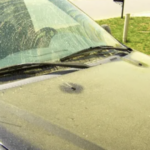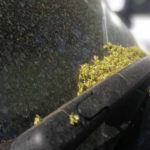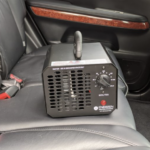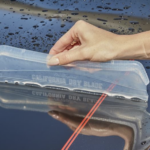How to Extend the Life of Your Car’s Paint and Prevent Fading
Why Car Paint Fades Faster in Florida
Florida’s climate presents unique challenges for car paint preservation. The combination of intense UV rays, high humidity, frequent rain, and salty coastal air leads to faster paint oxidation and fading.
Drivers in areas like Orlando, Winter Park, and Lake Mary experience sun exposure almost year-round, which gradually breaks down the clear coat. Those closer to the coast, such as Daytona Beach or Cocoa Beach, face additional risks from salt and sand, which accelerate corrosion.
Without proper care, even new vehicles can lose their deep, glossy finish within a few years, significantly reducing their resale value and appearance.
Factors That Cause Paint Fading
UV Rays and Sun Exposure
The sun’s UV rays break down the chemical bonds in the clear coat, leading to fading, dullness, and oxidation. Black and dark-colored cars fade even faster since they absorb more heat.
Oxidation from Heat and Humidity
When paint is exposed to excessive heat, it expands and contracts, causing microscopic cracks in the clear coat. These cracks allow moisture and contaminants to penetrate, leading to oxidation.
Acidic Rain and Air Pollution
Florida’s frequent rain showers may seem like a free car wash, but they leave behind mineral deposits and pollutants. If the car is not dried properly, water spots can form, etching into the paint over time.
Bird Droppings, Tree Sap, and Bug Splatter
Parking under trees in areas like Kissimmee, Windermere, or Altamonte Springs increases the chances of bird droppings and tree sap sticking to the paint. These contaminants are highly acidic and, if left untreated, can permanently stain or damage the paint.
Improper Washing Techniques
Using the wrong cleaning products or automatic car washes with abrasive brushes can scratch the clear coat, accelerating fading.
How to Protect Your Car’s Paint from Fading
1. Park in the Shade or Use a Car Cover
Whenever possible, park in covered garages, carports, or shaded areas to reduce sun exposure. If shade isn’t available, using a high-quality car cover helps block UV rays.
For residents in Lake Nona, Winter Garden, or Sanford, where outdoor parking is common, a UV-reflective car covercan make a significant difference in paint longevity.
2. Apply a Ceramic Coating or Paint Sealant
Ceramic coatings provide the best long-term protection against UV rays, oxidation, and environmental contaminants.
Benefits of ceramic coatings include:
- Repelling water and dirt, making cleaning easier.
- Preventing oxidation and fading from intense sun exposure.
- Enhancing gloss and depth for a long-lasting shine.
For those who prefer a more budget-friendly option, a synthetic paint sealant offers up to six months of protection and is easier to apply.
3. Wax Your Car Every Three Months
Applying a carnauba wax or synthetic wax every three months adds an extra layer of protection against UV rays and rain.
- Carnauba wax provides a deep shine but lasts only four to six weeks.
- Synthetic wax lasts longer (up to three months) and is more durable.
If you frequently park in high-exposure areas like downtown Orlando or Lake Mary, regular waxing helps maintain paint clarity.
4. Wash Your Car Regularly (But Correctly)
Frequent washing prevents contaminants from bonding to the paint. However, using the wrong technique can cause scratches and swirl marks, leading to premature fading.
Best practices for washing your car:
- Use a pH-balanced car shampoo to avoid stripping protective coatings.
- Wash in the shade to prevent water spots from forming.
- Use the two-bucket method to prevent dirt from scratching the surface.
- Dry with a microfiber towel instead of letting the car air dry.
Residents in Kissimmee, St. Cloud, and Apopka, where heavy rain leads to muddy roads, should wash their cars weekly to remove dirt and road grime.
5. Avoid Harsh Automatic Car Washes
Automatic car washes with spinning brushes can cause micro-scratches and swirl marks, leading to dull, faded paint over time. Instead, opt for:
- Touchless car washes, which use high-pressure water and soap instead of brushes.
- Hand washing, which is the safest way to preserve paint.
If using a self-serve car wash in areas like Oviedo or Altamonte Springs, bring your own microfiber mitt to avoid using harsh, pre-soaked brushes.
6. Remove Bird Droppings and Bug Splatter Immediately
Bird droppings, bug splatter, and tree sap contain acidic compounds that can eat through the clear coat if left for too long.
Quick removal tips:
- Use a detail spray and microfiber cloth for fresh droppings.
- For dried-on contaminants, soak a microfiber towel in warm water and lay it over the stain for a few minutes before wiping.
- Avoid scrubbing, as it can scratch the paint.
For those living near parks, lakes, or wooded areas like Clermont or Winter Park, keeping a small detailing kit in the car ensures quick cleanup when needed.
Dealing with Existing Paint Fading and Oxidation
If paint fading has already started, corrective detailing can restore clarity and shine.
1. Use a Clay Bar to Remove Contaminants
A clay bar treatment removes embedded dirt, pollutants, and oxidation buildup. This process smooths out the paint and preps it for polishing.
Best for:
- Vehicles with a rough, gritty surface even after washing.
- Cars exposed to heavy pollution and road grime in busy areas like I-4 or the 408 Expressway.
2. Machine Polishing for Heavily Oxidized Paint
If fading and oxidation are visible, machine polishing can restore depth and gloss.
How it works:
- A light polish removes surface oxidation and minor scratches.
- A medium-cut polish restores shine to dull, faded paint.
- After polishing, applying a ceramic coating or sealant locks in the new finish.
For extreme cases, a paint correction service from a professional detailer may be necessary.
3. Apply a Glaze to Enhance Shine
Glazes contain oils and fillers that temporarily hide minor imperfections and enhance depth. They work well for older cars that need a refresh but don’t require full paint correction.
However, glazes do not provide protection, so they should always be followed by a wax or sealant.
Long-Term Paint Protection Tips
✔ Wash and wax regularly to maintain a strong clear coat.
✔ Apply ceramic coatings for long-term durability.
✔ Use paint protection film on high-impact areas like bumpers and hoods.
✔ Park in covered areas whenever possible to reduce sun exposure.
✔ Avoid abrasive car wash brushes that create micro-scratches.
For those in Lake Nona, Windermere, or Winter Springs, where luxury vehicles and high-end finishes are common, investing in ceramic coatings and regular professional detailing ensures long-term protection.
Final Thoughts
Florida’s sun, humidity, and frequent rain make paint protection a priority for car owners. By using proper washing techniques, applying protective coatings, and taking preventive measures, drivers in Orlando, Kissimmee, Winter Park, and surrounding areas can keep their car’s paint looking new for years.
Regular maintenance not only preserves the vehicle’s appearance but also protects its resale value, ensuring it remains in top condition despite the challenging climate.
Leave a Comment Cancel Comment
Book Orlando Mobile Detailing
Search
Latest Post
-
 The Cost of Neglect: Why Regular Aircraft Detailing Saves Money in the Long Run
February 14, 2025
The Cost of Neglect: Why Regular Aircraft Detailing Saves Money in the Long Run
February 14, 2025
-
 Why Car Washes Aren’t Enough to Combat Pollen Damage
February 13, 2025
Why Car Washes Aren’t Enough to Combat Pollen Damage
February 13, 2025
-
 Orlando’s Pollen Problem: When Is It the Worst and How It Affects Your Car
February 13, 2025
Orlando’s Pollen Problem: When Is It the Worst and How It Affects Your Car
February 13, 2025
-
 How Ozone Generators Eliminate Stubborn Car Odors in Orlando
February 12, 2025
How Ozone Generators Eliminate Stubborn Car Odors in Orlando
February 12, 2025
-
 Why a Water Blade and Chamois Beat Towels Every Time!
February 9, 2025
Why a Water Blade and Chamois Beat Towels Every Time!
February 9, 2025
